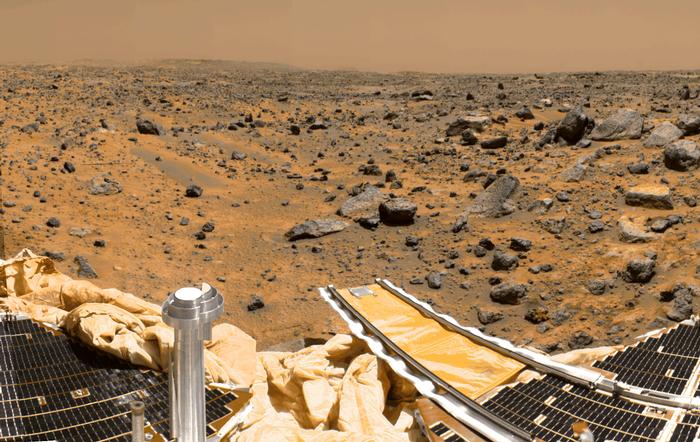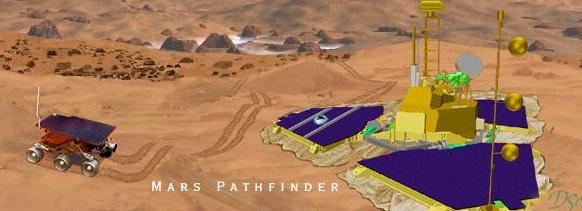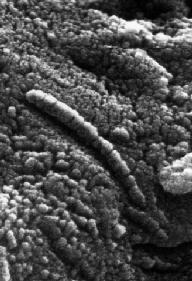ASTR 1210 (O'Connell) Study Guide

View of the Martian surface from the Mars Pathfinder lander (1997)
This Guide continues the discussion of Mars begun in Guide 16 and covers the successful Martian lander missions and the tantalizing but still marginal evidence for an early biosphere on Mars.F. Viking Lander Missions (1976)
- Viking was the most ambitious robot space mission to that time.
It consisted of two separate, nearly identical spacecraft, each
containing an orbiter and a lander component. The orbiters mapped
some 99% of Martian surface
- Click here for a Viking Project fact sheet.
- The Viking landers were very sophisticated experiments (though they did not "rove"), taking weather & soil samples at two sites and analyzing these with laboratory precision.
- Viking's primary goal was to perform a series
of lab
tests for organisms in the Martian soil. The basic technique for
the three experiments other than the mass spectrometer was to expose
Martian soil to nutrients or gases labeled with radioactive tracers.
If these were utilized by microorganisms in the soil, that could be
detected by subsequent tests.
- Test for the presence of organic molecules using a mass spectrometer
- Test for metabolism (solid ===> gas)
- Test for photosynthesis (gas ===> solid)
- Test for respiration (gas ===> gas)
- Results:
- The soil contains iron-rich minerals; iron oxides (rust) produce the red soil color
- No organic molecules were detected by the mass spectrometer
- A positive response was obtained from the "labeled release" metabolism experiment, which detected radioactively-tagged carbon dioxide emitted from the soil. But this result was ultimately attributed to the "strange" chemistry of iron-oxide rich material, not to biological activity. There is still controversy over the interpretation here, and some scientists argue that the Viking experiments did indeed provide evidence of microorganisms on Mars.
- Soil samples were taken only about 10-cm deep. They may not be representative because the surface may be sterilized by solar UV.
- Note that none of the later Martian lander missions have yet attempted to repeat the metabolism, photosynthesis, or respiration experiments of Viking, partly because of discouragement over the Viking results. So the absence of recent headlines about confirmation of life on Mars is an "absence of evidence, not evidence of absence."

Artist's concept of Mars Pathfinder Rover
G. Mars Pathfinder Mission (1997)
- Although Viking was a tremendous technological achievement, its apparent failure to identify life on Mars was a major disappointment to the space science community. Twenty years elapsed before another US lander mission was deployed. The Mars Pathfinder Mission was the first of a new series of moderate-cost Martian orbiters and landers intended to culminate in robot missions to return soil & rock samples to Earth.
- Novel airbag cushions permitted landing without the usual powerful (& heavy) retro-rockets. Here is an animation of how these work.
- MPF studied the atmosphere, soil, and rocks on Ares Vallis,
a floodplain region.
- Here is a view
of the landing site taken by the lander.
- MPF carried the first robot "rover" to sample rocks/soil within a few 10's of yards from the lander.
- The rover used an Alpha-Proton-X-ray Spectrometer to determine the mineral content of rocks by firing "alpha particles" (the nuclei of helium atoms) into the rocks and detecting the resulting emitted X-rays.
- Results: pebble & rock shapes give strong evidence for catastrophic floods in the distant past but only wind erosion (without water) since those. Some rocks appear to be sedimentary, forming during a long "wet-era" with stable liquid water on the surface. Most of the rocks are "andesites"---lava deposited molten but allowed to cool slowly or re-heated at a later time; similar to terrestrial rocks from Iceland. From precision measurements of Pathfinder's radio signal, there is dynamical evidence for an iron core in the Martian interior, implying (as expected) a hot, geologically active phase at early times.
H. Mars Exploration Rover Mission (2004)
- The MER mission consisted of two landers with rovers,
"Spirit" and "Opportunity," launched in mid-2003, which landed on Mars
in January 2004.
 Click here for QuickTime
animations of the launch and landing sequences of the MER mission.
Click here for QuickTime
animations of the launch and landing sequences of the MER mission.
- The landing sites were both chosen for their potential to demonstrate the presence of water on Mars in the past: Gusev Crater (Spirit) is a possible ancient lake bed; Meridiani Planum (Opportunity) is a plain with signs of a water-deposited mineral (hematite).
- The rovers were very robust, and traveled (slowly!) for large distances over the surface, a combined total of 30 miles. Opportunity spent almost two years exploring the Victoria crater and six months exploring Endurance crater.
- Both sites have yielded strong evidence of a watery past on Mars by detecting traces of specific minerals, such as "jarosite," "goethite," and "hematite blueberries," which are only produced in a water-rich environment, and layering which is expected for sedimentary rocks laid down at the edge of a lake or ocean. Rover "Spirit" also discovered deposits of silica, the product of igneous rocks exposed to hot water or steam, which is considered an excellent medium to host microbial life.

The wall of Victoria Crater as seen by the Opportunity Rover
I. Mars Phoenix Lander (2008)
-
The Phoenix site is closer to the north Martian pole than any other
lander. Phoenix did not carry a rover but was able to sample the soil and
determine its chemical composition and change of properties with temperature.
By testing for water vapor and watching changes as temperatures rose
above the melting point of water ice, Phoenix confirmed the presence of
large amounts of water frozen in the Martian soil. Liquid droplets,
probably water, formed and then evaporated from Phoenix's landing
struts.
J. Mars Science Laboratory/Curiosity Lander (2012)
- The MSL rover Curiosity, which successfully landed in August 2012, is a one-ton roving laboratory, the most elaborate experiment sent to Mars by that time. Getting it safely to ground involved a complex set of equipment and maneuvers.
- Curiosity carries the most elaborate set of diagnostic equipment yet sent to Mars before 2021 to study the geology and environment.
- Curiosity landed in Gale Crater and will study the sedimentary
deposits on the slope of "Mount Sharp" in the middle of the crater.
-
The unusual geology of Gale Crater arises from the fact that after the
crater was formed by a meteoroid impact, it was flooded with
sedimentary debris. The outer parts of the crater were subjected to
weathering by winds, which left a sedimentary mountain 18,000 feet
high in its center.
- In its early explorations, Curiosity used a drill to remove samples from inside a Martian rock lying in a ancient stream bed. Analysis with its on-board laboratory detected the presence of clays, sulfates, and other materials favorable to primitive lifeforms. The water content of soil minerals is estimated to be about 2%, which is substantial. Curiosity has ruled out a significant component of methane (CH4) in the Martian atmosphere, which would be expected if certain types of bacteria thrived in the soil.
K. Mars 2020: Perseverance Rover and Ingenuity Helicopter (2021)
- The Mars 2020 Mission made a successful landing in Jezero Crater, near the equator, on Mars on February 18, 2021. The most ambitious rover mission yet, Perseverence is nuclear-powered for a longer lifetime and is intended to search for evidence of (microbial) life on Mars. It is exploring the sediments on the bed of an ancient lake that filled the crater and might have been life-bearing in the first billion years or so after Mars formed.
- By 2025, the Perseverance rover had driven a total of over 24 miles across the Martian surface. Here is a high resolution video panorama of the area surrounding the rover after about 16 months of exploration. It includes a view of the extended "delta" region at the end of an ancient river that flowed into the crater.
- As it traverses the crater floor, Perserverance regularly stores samples, most drilled from rocks, for later return to Earth by the planned Mars Sample Return Mission. Over 30 sample tubes have been filled so far.
- Perseverance also carried the first aircraft ever taken to another planet, the mini-helicopter Ingenuity. Intended as an experiment, it had to be specially designed to fly in the very thin Martian atmosphere. However, it was a great success, flying autonomously over 70 times and serving as a pathfinder for the rover.

Perseverance and helicopter Ingenuity on Mars
L. "SNC" Meteorites: an unexpected window on Mars
- "SNC" meteorites are a rare class of meteorite (only 99 of 53000 fall in this group) found on Earth.
- By matching their composition to data from the Martian
landers, geologists realized that the SNC's
are fragments of the Martian surface, ejected
by asteroid impacts,
which have happened to travel to Earth and survive passage through the
atmosphere.
- They are mostly about 1 Byr old. (Typical meteorite remnants of the solar nebula would be much older, at about 4.5 Byr.)
- Their argon isotope ratios match results from the Viking and Curiosity landers and are very different from Earth or Jupiter ratios, indicating a major loss of atmospheric gases from Mars at some time in the past.
- Analysis of the SNC minerals indicates that Mars was once very wet, with a global water layer perhaps several 100 meters deep. The SNC results support the extensive imaging and other evidence for massive water flows in the past on Mars.

M. Microscopic Life on Mars??
- ALH 84001 is a SNC meteorite recovered from an Antarctic meteorite field. It is over 3.5 Byr old
- It contains several features which are suggestive of the presence
of ancient microorganisms
- Carbonate inclusions. "PAH" molecules, which may imply biosynthesis.
- Microfossils (0.0001 mm) (see image at right; click for an enlarged view)
- The implication is that bacterial life may have existed on Mars during the "wet era", 1-4 Byr ago
- But this interpretation is controversial. See the Lunar & Planetary Institute web site for links discussing various sides of the debate.
N. Martian Satellites
- Mars has two satellites: Phobos & Deimos, discovered in 1877.
- These are both small (10-17 mi) and irregular in shape.
- They are captured asteroids. Viking images of them afforded us our first close-up view of asteroids. More recent images of both satellites are compared here.
O. Expeditions to Mars
-
Serious proposals for human expeditions to Mars have been around for
over 50 years. Many prelminary conceptual designs have been
considered (for details,
see this
article). In January 2004, President Bush proposed a long term
commitment (20+ years) to a program that would send expeditions back
to the Moon and ultimately to Mars but did not commit funding for a
project of this scale. NASA today continues to develop spacecraft
with the ultimate goal of a Mars mission but without an explicit
government commitment to one.
In the last five years, private space venture companies have expressed
greater interest in a Mars mission. In April 2016,
SpaceX
announced plans for a robotic mission to Mars in 2018 as a prelude
to
an Interplanetary
Transport System, which might support manned missions in perhaps
10 years. NASA is assisting SpaceX, but most of the funding for its
Mars program will be private in the near term.
Human space missions are much more costly than the robot craft we have
used for all previous studies of Mars because of the life support
systems needed (both during the trip and once on Mars' surface).
However, many people are eager to go---for both scientific and
personal reasons---and are
exploring the various necessary survival technologies. There is
much discussion of "terraforming" Mars---i.e. making it
suitable for human colonies by releasing trapped water onto its
surface and generating oxygen for a breathable atmosphere.

Artist's concept of a human expedition to Valles Marinaris.
Reading for this lecture:
-
Study Guide 17
Bennett textbook, p. 206, Sec. 9.4.
-
H. G. Wells War of the Worlds
Study Guide 18
Web Links:
-
Study Guide 16 (Mars I, including general links)
Selected Mars Images and Evidence for Water
(O'Connell)
Viking Mission
-
A 40-year perspective on the Viking landers (Joel Achenbach, June 2016)
Mars Exploration Rover Mission
Phoenix Mars Mission Mars Science Laboratory/Curiosity Rover Mission
-
"Seven Minutes of Terror" -- Video
showing risky landing sequence of Curiosity, successfully executed in August 2012
SNC Meteorite Analysis (Eric Weisstein)
Critical Discussion of Martian Meteorite/Life Science Red Colony, one of many websites devoted to space colonization
The Mars Homestead Project, another colonization site.
Discussion of Terraforming (Wikipedia) The Martian, a 2015 film realistically portraying the challenges facing human colonies on Mars.
 Previous Guide
Previous Guide
|
 Guide Index
Guide Index
|
 Next Guide
Next Guide
|